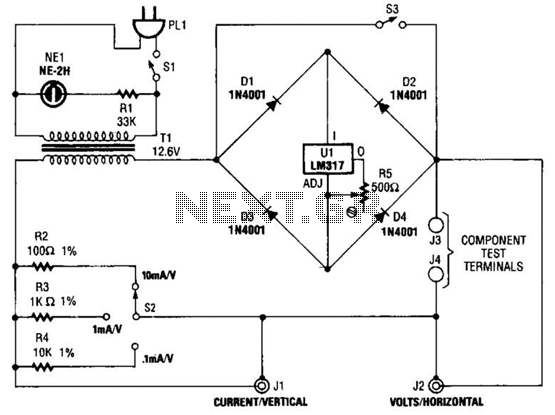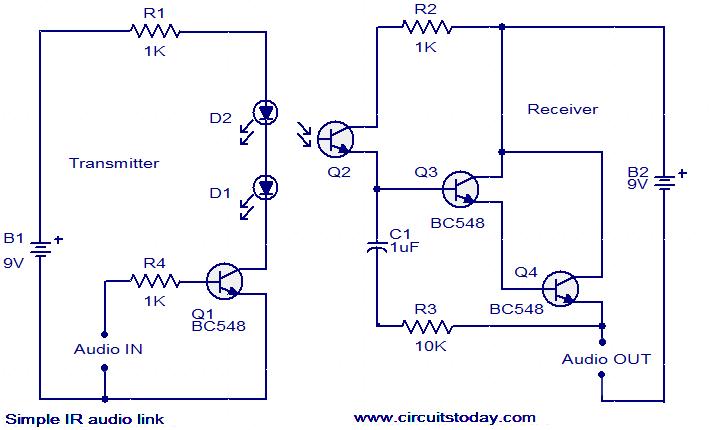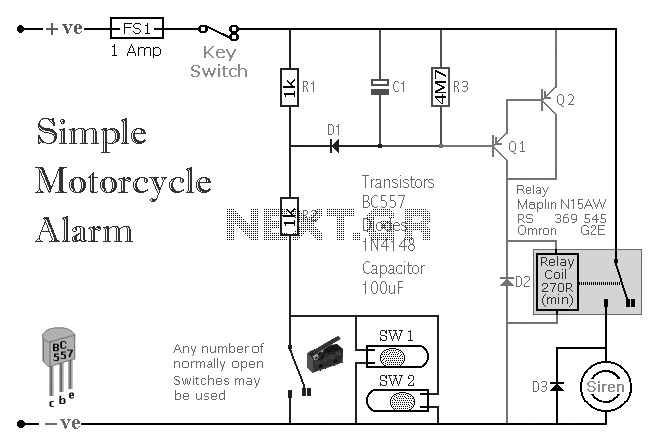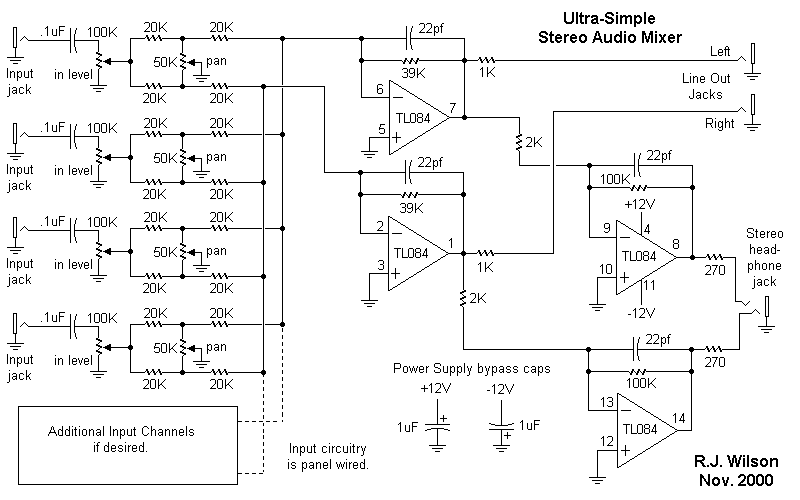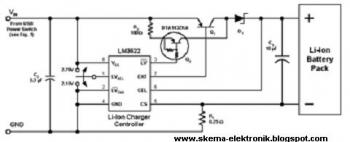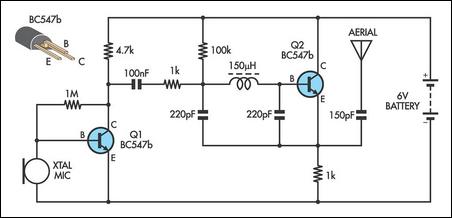
Simple applications of neon glow lamps

To create a telephone ring monitor, it is sufficient to connect a resistor in series with a bulb and plug it into a main outlet. The resistance value of this resistor may vary depending on the type of bulb and the main voltage; however, it is not critical. Recommended values are approximately 150 kΩ for 220-230 Vac and about 39 kΩ for 110-120 Vac. It is essential to select a resistor that can handle the desired voltage or to connect two or more standard resistors in series. The power rating of the resistor is relatively low, with a 0.25 W rating typically being adequate. A neon glow lamp requires a relatively high voltage (around 70 V) to illuminate, which simplifies the implementation of a telephone ring monitor. The voltage on the telephone line is usually less than 50 V, insufficient to illuminate the lamp. When the phone rings, an AC voltage of approximately 150 Vac is present on the line, causing the bulb to glow. The low current consumption of glow lamps is advantageous in this scenario as it does not overload the phone line. It should be noted that in certain countries, connecting non-certified devices to a telephone line is prohibited; thus, this application is presented solely for educational purposes. If the lamp continues to glow after the ringing has stopped, it indicates that the maintaining voltage of the lamp is too low (lower than the telephone idle voltage). To rectify this issue, two Zener diodes rated between 20 to 30 V can be connected in series, back to back, with the lamp. Typically, the neutral and earth wires are connected together in the transformer, which short circuits the lamp, preventing it from glowing. If the earth wire is not connected or if the live and neutral wires are reversed, the full voltage will be present at the lamp terminals, causing it to glow and indicating a problem. This circuit design is straightforward but cannot detect all erroneous connections; for instance, if the neutral wire is disconnected, the lamp will not illuminate even if there is an issue with the earth wire. Generally, the neutral and earth wires are at the same electrical potential, and the two 150 kΩ resistors are in parallel, causing all three lamps to glow. If a connection is missing or inverted, the resistors will form a voltage divider, reducing the voltage and resulting in one or more lamps remaining dark. The two anti-series Zener diodes are included to prevent the lamps from glowing at approximately half of the main voltage.
The telephone ring monitor circuit operates effectively by utilizing a series resistor with a bulb, which allows for the detection of ringing voltage on the telephone line. The selection of resistor values is crucial for ensuring proper functionality across different voltage levels. The implementation of Zener diodes provides an additional layer of protection, regulating the voltage across the lamp to prevent it from glowing under incorrect conditions.
In practical applications, the circuit can be integrated into a telephone line monitoring system, allowing users to visually confirm incoming calls without interfering with the line's primary function. The design is minimalistic, relying on basic components such as resistors, a neon lamp, and Zener diodes, making it accessible for educational demonstrations and experiments in electronics.
It is important to highlight that safety considerations must be taken into account when working with electrical circuits connected to telephone lines, as improper connections can lead to equipment damage or safety hazards. Therefore, this circuit should only be constructed and tested by individuals with adequate knowledge of electrical systems.To obtain such a monitor it`s enough to connect a resistor in series with the bulb and connect at a main outlet. The resistance of that resistor may vary on the type of bulb and the main voltage but it`s not critical: about 150K © for 220.
230Vac and about 39K © for 110. 120Vac. It`s very important to choose a resistor that can support the desired v oltage or connect two or more usual resistors in series. The power of that resistor is quite low and a 0. 25W is usually enough. To light a neon glow lamp a relatively high voltage is necessary (about 70V) and this make the realization of a telephone ring monitor quite easy: the voltage of the telephone line is usually less than 50V and it`s not enough to start the lamp. When the phone rings an AC voltage of about 150Vac is present on the line and the bulb will glow. The low current consumption of glow lamps is very useful in this case since it doesn`t overload the phone line.
In certain countries the connection to a telephone line of non certified devices (such as this one) is not allowed. This application is only presented for didactic proposes. If the lamp keeps glowing after the ringer, the maintaining voltage of the lamp is too low (lower than the telephone idle voltage).
To solve this problem just connect two Zener diodes of about 20 to 30V in series back to back in series with the lamp. In facts the neutral wire and the earth wire are usually connected together in the transformer and this connection short circuits the lamp that cannot glow.
If the earth wire is not connected or if the live and neutral wires are inverted the full voltage would be present on the terminals of the lamp that would glow indicating the presence of a problem. This circuit is very simple and cannot detect every false connection; for example if the neutral wire is not connected the lamp can`t glow even if there is a problem with the earth wire.
Usually the neutral and the earth are at the same electrical potential and the two resistors of 150K © are in parallel making all three lamps glow. If a connection is missing or is inverted the resistors will form a voltage divider that reduces the voltage and makes one or more lamps dark.
The two anti-series zener diodes are there to avoid that the lamps glows with about the half of the main voltage. 🔗 External reference
The telephone ring monitor circuit operates effectively by utilizing a series resistor with a bulb, which allows for the detection of ringing voltage on the telephone line. The selection of resistor values is crucial for ensuring proper functionality across different voltage levels. The implementation of Zener diodes provides an additional layer of protection, regulating the voltage across the lamp to prevent it from glowing under incorrect conditions.
In practical applications, the circuit can be integrated into a telephone line monitoring system, allowing users to visually confirm incoming calls without interfering with the line's primary function. The design is minimalistic, relying on basic components such as resistors, a neon lamp, and Zener diodes, making it accessible for educational demonstrations and experiments in electronics.
It is important to highlight that safety considerations must be taken into account when working with electrical circuits connected to telephone lines, as improper connections can lead to equipment damage or safety hazards. Therefore, this circuit should only be constructed and tested by individuals with adequate knowledge of electrical systems.To obtain such a monitor it`s enough to connect a resistor in series with the bulb and connect at a main outlet. The resistance of that resistor may vary on the type of bulb and the main voltage but it`s not critical: about 150K © for 220.
230Vac and about 39K © for 110. 120Vac. It`s very important to choose a resistor that can support the desired v oltage or connect two or more usual resistors in series. The power of that resistor is quite low and a 0. 25W is usually enough. To light a neon glow lamp a relatively high voltage is necessary (about 70V) and this make the realization of a telephone ring monitor quite easy: the voltage of the telephone line is usually less than 50V and it`s not enough to start the lamp. When the phone rings an AC voltage of about 150Vac is present on the line and the bulb will glow. The low current consumption of glow lamps is very useful in this case since it doesn`t overload the phone line.
In certain countries the connection to a telephone line of non certified devices (such as this one) is not allowed. This application is only presented for didactic proposes. If the lamp keeps glowing after the ringer, the maintaining voltage of the lamp is too low (lower than the telephone idle voltage).
To solve this problem just connect two Zener diodes of about 20 to 30V in series back to back in series with the lamp. In facts the neutral wire and the earth wire are usually connected together in the transformer and this connection short circuits the lamp that cannot glow.
If the earth wire is not connected or if the live and neutral wires are inverted the full voltage would be present on the terminals of the lamp that would glow indicating the presence of a problem. This circuit is very simple and cannot detect every false connection; for example if the neutral wire is not connected the lamp can`t glow even if there is a problem with the earth wire.
Usually the neutral and the earth are at the same electrical potential and the two resistors of 150K © are in parallel making all three lamps glow. If a connection is missing or is inverted the resistors will form a voltage divider that reduces the voltage and makes one or more lamps dark.
The two anti-series zener diodes are there to avoid that the lamps glows with about the half of the main voltage. 🔗 External reference
